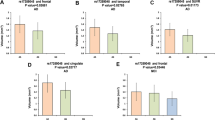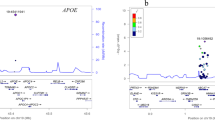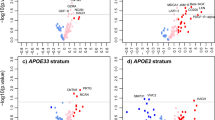Abstract
The CR1 gene has been widely studied in Alzheimer’s disease (AD), since its first association with the disease in 2009. Even after 11 years of this discovery, the role of this gene in AD has not yet been fully elucidated and the association of its variants was not validated in Latin American populations. We genotyped five CR1 single nucleotide polymorphisms (SNPs rs6656401, rs3849266, rs2274567, rs4844610, and rs12034383) in up to 162 AD patients and 137 controls through PCR-SSP and iPLEX MassARRAY Platform (Sequenom), and measured soluble CR1 (sCR1) levels in plasma of 40 AD patients and 39 controls with an enzyme-linked immunosorbent assay (ELISA). Homozygosity for haplotype rs3849266*C_rs2274567*A (CA/CA genotype) was associated with susceptibility to AD (OR = 2.94, p = 0.018). Patients presented higher sCR1 levels in plasma than controls (p = 0.038). Furthermore, patients that carry the rs2274567*G allele (p.1208Arg) presented higher sCR1 levels than A/A (p.1208His/His) homozygotes (p = 0.036). This is the first study to validate the association of CR1 polymorphisms with late-onset Alzheimer’s disease, as well as to evaluate sCR1 levels in a Latin American population. SNPs present in the regulatory and coding regions of this gene may be playing a key role in the observed association, probably by interfering in Aβ plaques clearance. Inhibition may be due to the increase in local sCR1 levels observed in patients, which may result from polymorphisms leading to larger isoforms of CR1 and/or structural alterations of the protein that makes it less functional, as well as increased vesiculation of the molecules.


Similar content being viewed by others
References
Almeida JFF, dos Santos LR, Trancozo M, de Paula F (2018) Updated meta-analysis of BIN1, CR1, MS4A6A, CLU, and ABCA7 variants in Alzheimer’s disease. J Mol Neurosci 64:471–477. https://doi.org/10.1007/s12031-018-1045-y
Barrett JC, Fry B, Maller J, Daly MJ (2005) Haploview: analysis and visualization of LD and haplotype maps. Bioinformatics 21:263–265. https://doi.org/10.1093/bioinformatics/bth457
Bateman A, Martin MJ, O’Donovan C et al (2017) UniProt: the universal protein knowledgebase. Nucleic Acids Res 45:D158–D169. https://doi.org/10.1093/nar/gkw1099
Benjamini Y, Hochberg Y (1995) Controlling the false discovery rate : a practical and powerful approach to multiple testing. J R Stat Soc B 57:289–300
Boyle AP, Hong EL, Hariharan M, Cheng Y, Schaub MA, Kasowski M, Karczewski KJ, Park J, Hitz BC, Weng S, Cherry JM, Snyder M (2012) Annotation of functional variation in personal genomes using RegulomeDB. Genome Res 22:1790–1797. https://doi.org/10.1101/gr.137323.112
Braak H, Braak E (1991) Neuropathological stageing of Alzheimer-related changes. Acta Neuropathol 82:239–259. https://doi.org/10.1007/BF00308809
Brouwers N, Van Cauwenberghe C, Engelborghs S et al (2012) Alzheimer risk associated with a copy number variation in the complement receptor 1 increasing C3b/C4b binding sites. Mol Psychiatry 17:223–233. https://doi.org/10.1038/mp.2011.24
Cohen JHM, Atkinson JP, Klickstein LB, Oudin S, Subramanian VB, Moulds JM (1999) The C3b/C4b receptor (CR1, CD35) on erythrocytes: methods for study of the polymorphisms. Mol Immunol 36:819–825
Consortium T 1000 GP (2010) A map of human genome variation from population-scale sequencing. Nature 467:1061–1073. https://doi.org/10.1038/nature09534
Crehan H, Holton P, Wray S, Pocock J, Guerreiro R, Hardy J (2012) Complement receptor 1 (CR1) and Alzheimer’s disease. Immunobiology 217:244–250. https://doi.org/10.1016/j.imbio.2011.07.017
Daborg J, Andreasson U, Pekna M, Lautner R, Hanse E, Minthon L, Blennow K, Hansson O, Zetterberg H (2012) Cerebrospinal fluid levels of complement proteins C3, C4 and CR1 in Alzheimer’s disease. J Neural Transm 119:789–797. https://doi.org/10.1007/s00702-012-0797-8
Danielsson C, Pascual M, French L, Steiger G, Schifferli JA (1994) Soluble complement receptor type 1 (CD35) is released from leukocytes by surface cleavage. Eur J Immunol 24:2725–2731. https://doi.org/10.1002/eji.1830241123
Dervillez X, Oudin S, Libyh MT, Tabary T, Reveil B, Philbert F, Bougy F, Pluot M, Cohen JHM (1997) Catabolism of the human erythrocyte C3b/C4b receptor (CR1, CD35) : vesiculation and/or proteolysis? Immunopharmacology 38:129–140. https://doi.org/10.1016/S0162-3109(97)00066-0
dos Santos LR, Pimassoni LHS, Sena GGS, Camporez D, Belcavello L, Trancozo M, Morelato RL, Errera FIV, Bueno MRP, de Paula F (2017) Validating GWAS variants from microglial genes implicated in Alzheimer’s disease. J Mol Neurosci 62:215–221. https://doi.org/10.1007/s12031-017-0928-7
Duthey B (2013) Background paper 6.11 Alzheimer disease and other dementias. World heal organ 1–77
Farfel JM, Yu L, Buchman AS, Schneider JA, de Jager PL, Bennett DA (2016) Relation of genomic variants for Alzheimer disease dementia to common neuropathologies. Neurology 87:489–496
Farrer LA, Cupples LA, Haines JL et al (1997) Effects of age, sex, and ethnicity on the association between apolipoprotein E genotype and Alzheimer disease. JAMA 278:1349. https://doi.org/10.1001/jama.1997.03550160069041
Frota NAF, Nitrini R, Damasceno BP et al (2011) Critérios para diagnóstico de doença de Alzheimer. Dement Neuropsychol 5:5–10
Hamer I, Paccaud J, Belin D et al (1998) Soluble form of complement C3b/C4b receptor (CR1) results from a proteolytic cleavage in the C-terminal region of CR1 transmembrane domain. Biochem J 329:183–190
Hazrati LN, Van Cauwenberghe C, Brooks PL et al (2012) Genetic association of CR1 with Alzheimer’s disease: a tentative disease mechanism. Neurobiol Aging 33:2949.e5–2949.e12. https://doi.org/10.1016/j.neurobiolaging.2012.07.001
Heppner FL, Ransohoff RM, Becher B (2015) Immune attack: the role of inflammation in Alzheimer disease. Nat Rev Neurosci 16:358–372. https://doi.org/10.1038/nrn3880
Klimkowicz-Mrowiec A, Sado M, Dziubek A, Dziedzic T, Pera J, Szczudlik A, Słowik A (2013) Lack of association of CR1, PICALM and CLU gene polymorphisms with Alzheimer disease in a Polish population. Neurol Neurochir Pol 47:157–160. https://doi.org/10.5114/ninp.2013.33825
Kretzschmar GC, Oliveira LC, Nisihara RM, Velavan TP, Stinghen ST, Stahlke ERS, Petzl-Erler ML, Messias-Reason IJT, Boldt ABW (2018) Complement receptor 1 (CR1, CD35) association with susceptibility to leprosy. PLoS Negl Trop Dis 12:e0006705. https://doi.org/10.1371/journal.pntd.0006705
Kullo IJ, Ding KY, Shameer K, McCarty CA, Jarvik GP, Denny JC, Ritchie MD, Ye Z, Crosslin DR, Chisholm RL, Manolio TA, Chute CG (2011) Complement receptor 1 gene variants are associated with erythrocyte sedimentation rate. Am J Hum Genet 89:131–138. https://doi.org/10.1016/j.ajhg.2011.05.019
Lahiri DK, Numberger JI (1991) A rapid non-enzymatic method for the preparation of HMW DNA from blood for RFLP studies. Nucleic Acids Res 19:5444. https://doi.org/10.1093/nar/19.19.5444
Lambert J-C, Heath S, Even G et al (2009) Genome-wide association study identifies variants at CLU and CR1 associated with Alzheimer’s disease. Nat Genet 41:1094–1099. https://doi.org/10.1038/ng.439
Lane CA, Hardy J, Schott JM (2018) Alzheimer’s disease. Eur J Neurol 25:59–70. https://doi.org/10.1111/ene.13439
Liu D, Niu Z-X (2009) The structure, genetic polymorphisms, expression and biological functions of complement receptor type 1 (CR1/CD35). Immunopharmacol Immunotoxicol 31:524–535. https://doi.org/10.3109/08923970902845768
Machiela MJ, Chanock SJ (2018) LDassoc: an online tool for interactively exploring genome-wide association study results and prioritizing variants for functional investigation. Bioinformatics 34:887–889. https://doi.org/10.1093/bioinformatics/btx561
Mahmoudi R, Kisserli A, Novella J-L et al (2015) Alzheimer’s disease is associated with low density of the long CR1 isoform. Neurobiol Aging 36:1766.e5–1766.12. https://doi.org/10.1016/j.neurobiolaging.2015.01.006
Mahmoudi R, Feldman S, Kisserli A, Duret V, Tabary T, Bertholon LA, Badr S, Nonnonhou V, Cesar A, Neuraz A, Novella J, Cohen J (2018) Inherited and acquired decrease in complement receptor 1 (CR1) density on red blood cells associated with high levels of soluble CR1 in Alzheimer’s disease. Int J Mol Sci 19:2175. https://doi.org/10.3390/ijms19082175
Moreno DJ, Ruiz S, Ríos Á, Lopera F, Ostos H, Via M, Bedoya G (2017) Association of GWAS top genes with late-onset Alzheimer’s disease in Colombian population. Am J Alzheimer’s Dis Other Dementiasr 32:27–35. https://doi.org/10.1177/1533317516679303
Morgan K, Carrasquillo MM (2013) Genetic variants in Alzheimer’s disease. Springer New York, New York
Nédélec Y, Sanz J, Baharian G et al (2016) Genetic ancestry and natural selection drive population differences in immune responses to pathogens. Cell 167:657–669.e21. https://doi.org/10.1016/j.cell.2016.09.025
Panda AK, Ravindran B, Das BK (2016) CR1 exon variants are associated with lowered CR1 expression and increased susceptibility to SLE in a Plasmodium falciparum endemic population. Lupus Sci Med 3:e000145. https://doi.org/10.1136/lupus-2016-000145
Pascual M, Lutz HU, Steiger G et al (1993) Release of vesicles enriched in complement receptor 1 from human erythrocytes. J Immunol 151:397–404
Ricklin D, Hajishengallis G, Yang K, Lambris JD (2010) Complement: a key system for immune surveillance and homeostasis. Nat Immunol 11:785–797. https://doi.org/10.1038/ni.1923
Ripoche J, Sim RB (1986) Loss of complement receptor type 1 (CR1) on ageing of erythrocytes. Studies of proteolytic release of the receptor. Biochem J 235:815–821
Rogers J, Li R, Mastroeni D, Grover A, Leonard B, Ahern G, Cao P, Kolody H, Vedders L, Kolb WP, Sabbagh M (2006) Peripheral clearance of amyloid β peptide by complement C3-dependent adherence to erythrocytes. Neurobiol Aging 27:1733–1739. https://doi.org/10.1016/j.neurobiolaging.2005.09.043
Santos-Rebouças CB, Gonçalves AP, dos Santos JM, Abdala BB, Motta LB, Laks J, de Borges MB, de Rosso ALZ, Pereira JS, Nicaretta DH, Pimentel MMG (2017) rs3851179 polymorphism at 5′ to the PICALM gene is associated with Alzheimer and Parkinson diseases in Brazilian population. NeuroMolecular Med 19:293–299
Shen N, Chen B, Jiang Y, et al (2014) An updated analysis with 85,939 samples confirms the association between CR1 rs6656401 polymorphism and Alzheimer’s disease. Mol Neurobiol 1017–1023. https://doi.org/10.1007/s12035-014-8761-2
Ward LD, Kellis M (2012) HaploReg: a resource for exploring chromatin states, conservation, and regulatory motif alterations within sets of genetically linked variants. Nucleic Acids Res 40:D930–D934. https://doi.org/10.1093/nar/gkr917
Webster S, Bradt B, Rogers J, Cooper N (1997) Aggregation state-dependent activation of the classical complement pathway by the amyloid β peptide. J Neurochem 69:388–398. https://doi.org/10.1046/j.1471-4159.1997.69010388.x
Xiao-Ying M, Jin-Tai Y, Meng-Shan T et al (2014) Missense variants in CR1 are associated with increased risk of Alzheimer’ disease in Han Chinese. Neurobiol Aging 35:443.e17–443.e21. https://doi.org/10.1016/j.neurobiolaging.2013.08.009
Acknowledgments
We are deeply grateful for the patients’ participation in this study and thank the staff of the Polymorphism and Linkage Laboratory/UFPR for their assistance in DNA extraction.
Funding
This work was supported by grants of Fundação Araucária (FA-protocol 39894.413.43926.1904/2013 and 116/2018, protocol 50.530), Coordenação de Aperfeiçoamento de Pessoal de Nível Superior–Brasil (CAPES-40001016006P1) and Conselho Nacional de Desenvolvimento Científico e Tecnológico (CNPq-314288/2018-0). The funding agencies had no role in study design, in the collection, analysis and interpretation of data, in the writing of the letter, and in the decision to submit it for publication.
Author information
Authors and Affiliations
Contributions
Conceptualization: GCK and ABWB; methodology: GCK, AAHA, LCO, and RMN; formal analysis and investigation: GCK and AAHA; writing—original draft preparation: GCK; writing—review and editing: all the authors; funding acquisition: MLEP, RLRS, and ABWB; supervision: ABWB. All authors read and approved the final manuscript.
Corresponding author
Ethics declarations
Ethical Approval
All procedures performed in studies involving human participants were in accordance with the ethical standards of the Research Ethics Committee of the Health Sciences Sector (Federal University of Paraná) (CAAE: 55965316.1.0000.0102), according to Resolution 466/2012 of the National Health Council and with the 1964 Helsinki declaration and its later amendments or comparable ethical standards. Informed consent was obtained from all individual participants included in the study.
Conflict of Interests
The authors declare that they have no conflict of interest.
Additional information
Publisher’s Note
Springer Nature remains neutral with regard to jurisdictional claims in published maps and institutional affiliations.
Gabriela Canalli Kretzschmar and Angela Adriane Hanel Antoniazzi are first authors.
Electronic supplementary material
Online Resource 1
(PDF 507 kb)
Online Resource 2
(PDF 518 kb)
Online Resource 3
(PDF 516 kb)
Online Resource 4
(PDF 512 kb)
Online Resource 5
(PDF 513 kb)
Online Resource 6
(PDF 515 kb)
Online Resource 7
(PDF 501 kb)
Rights and permissions
About this article
Cite this article
Kretzschmar, G.C., Antoniazzi, A.A.H., Oliveira, L.C. et al. First Report of CR1 Polymorphisms and Soluble CR1 Levels Associated with Late Onset Alzheimer’s Disease (LOAD) in Latin America. J Mol Neurosci 70, 1338–1344 (2020). https://doi.org/10.1007/s12031-020-01547-2
Received:
Accepted:
Published:
Issue Date:
DOI: https://doi.org/10.1007/s12031-020-01547-2




